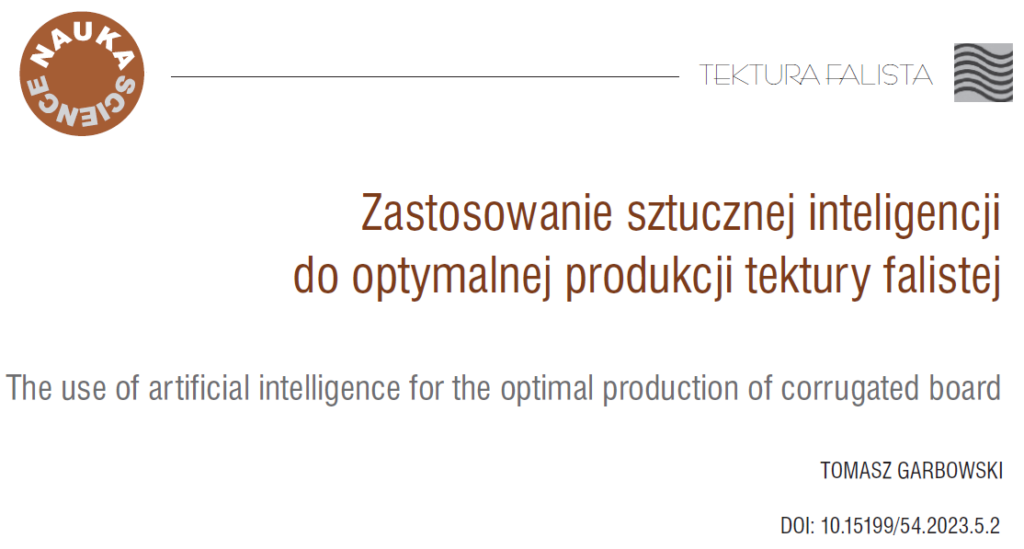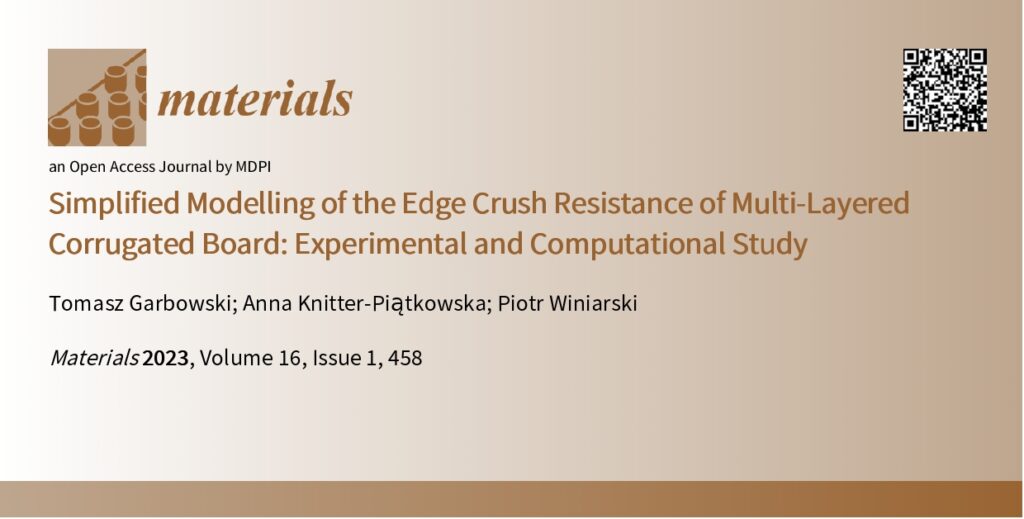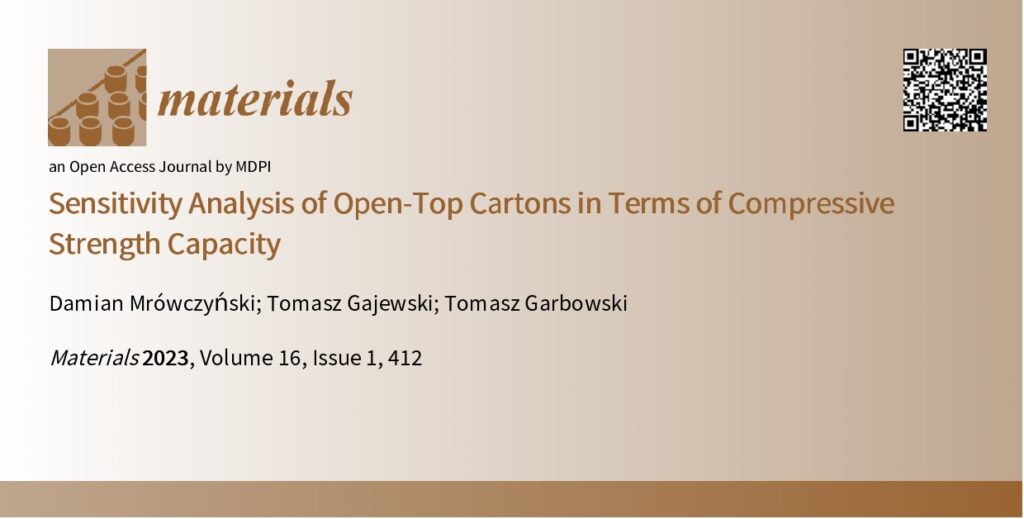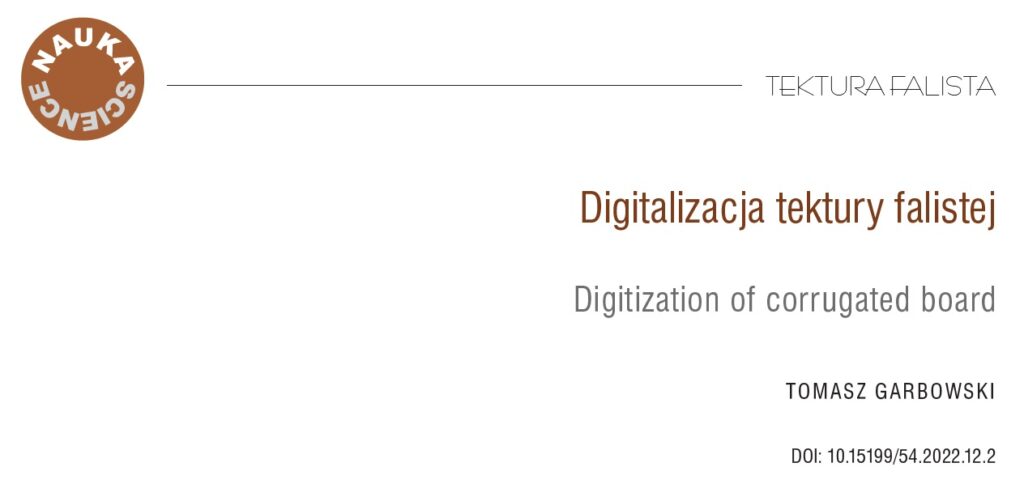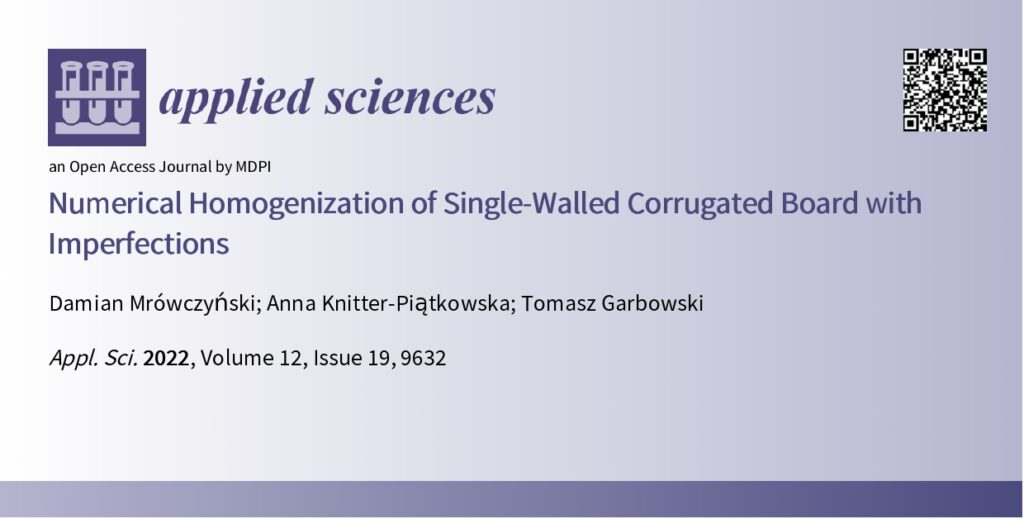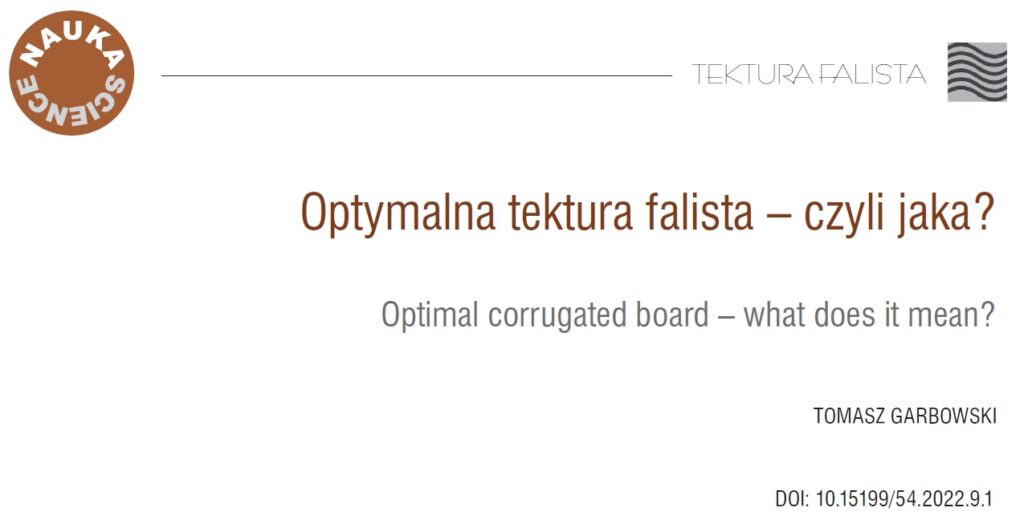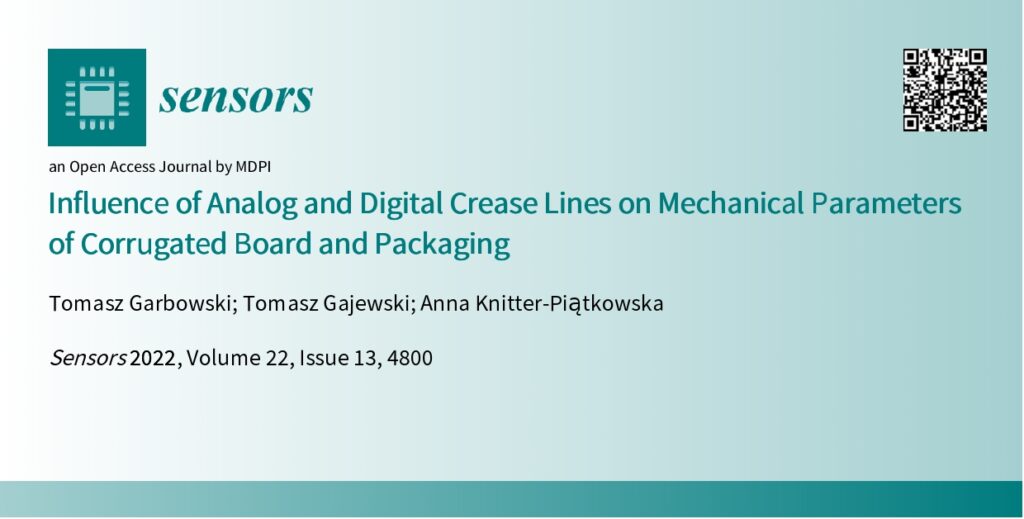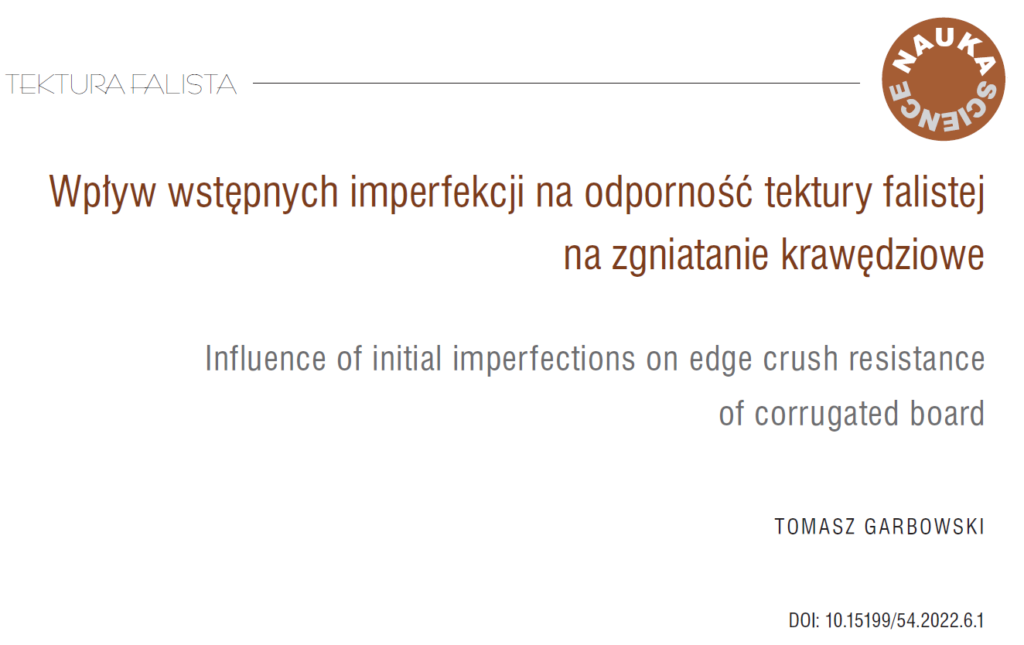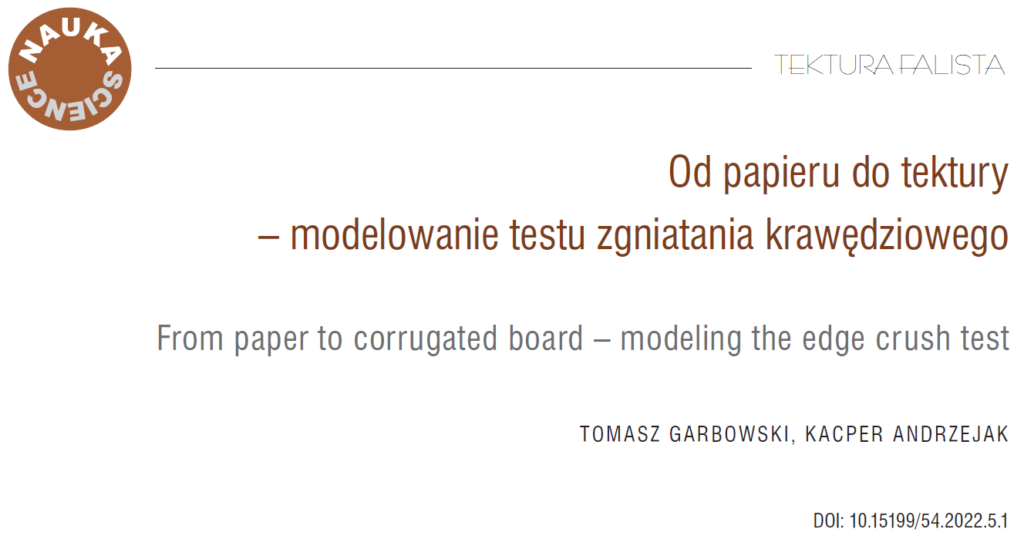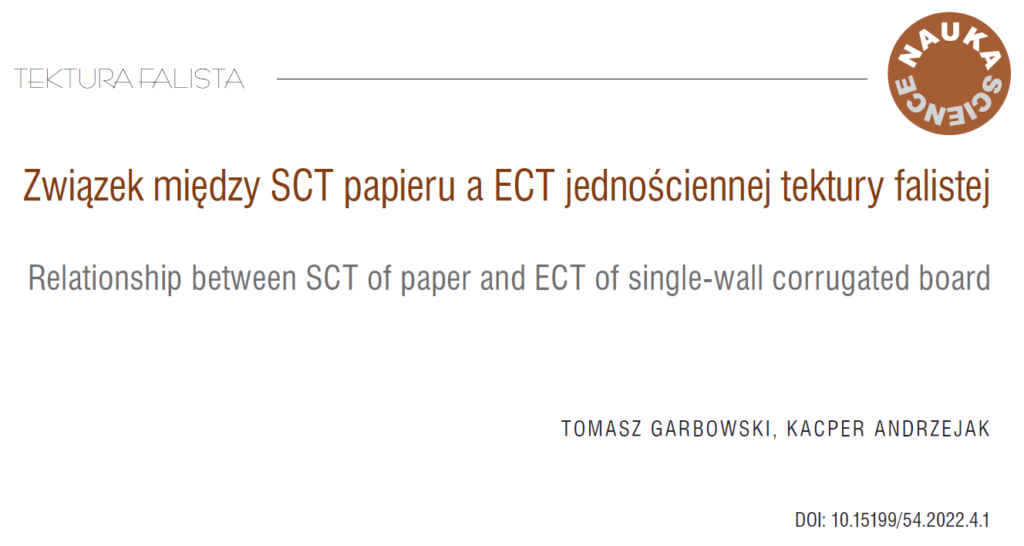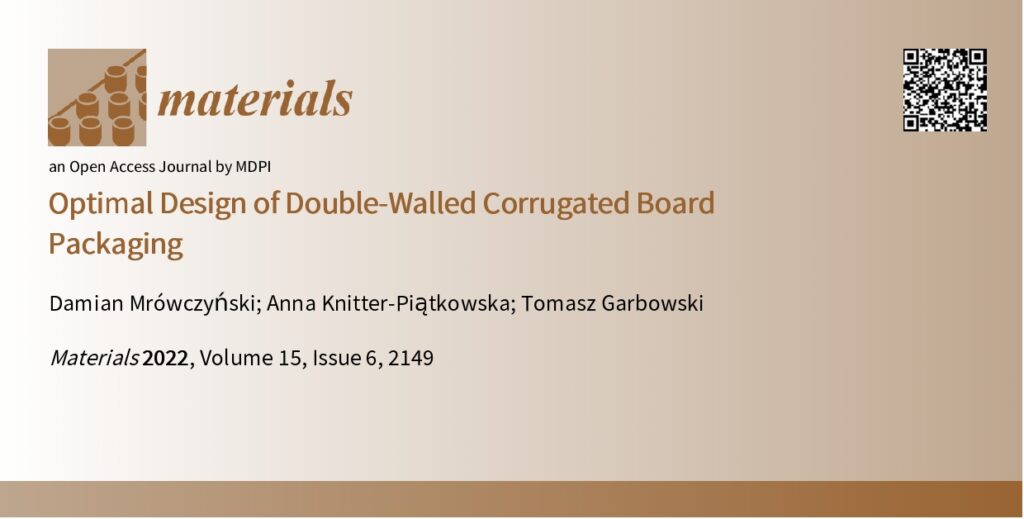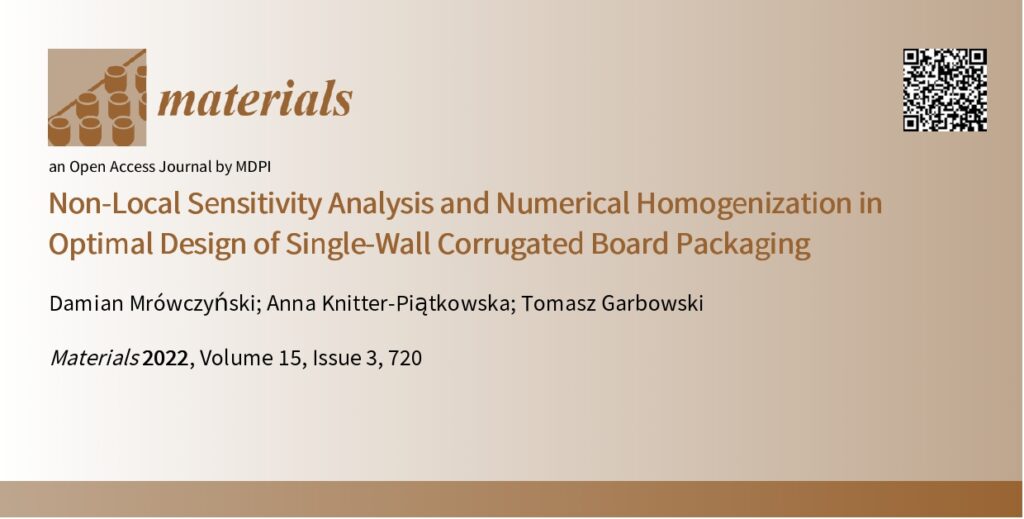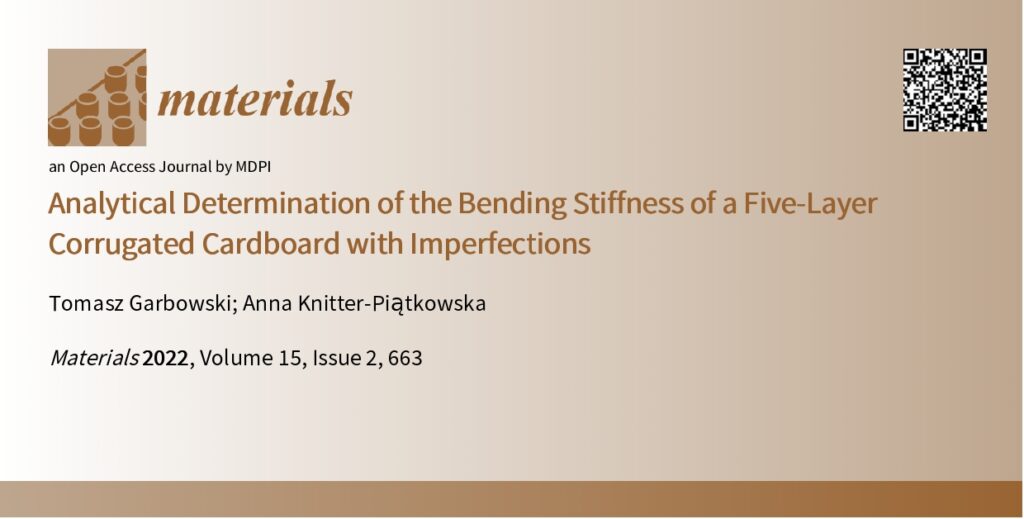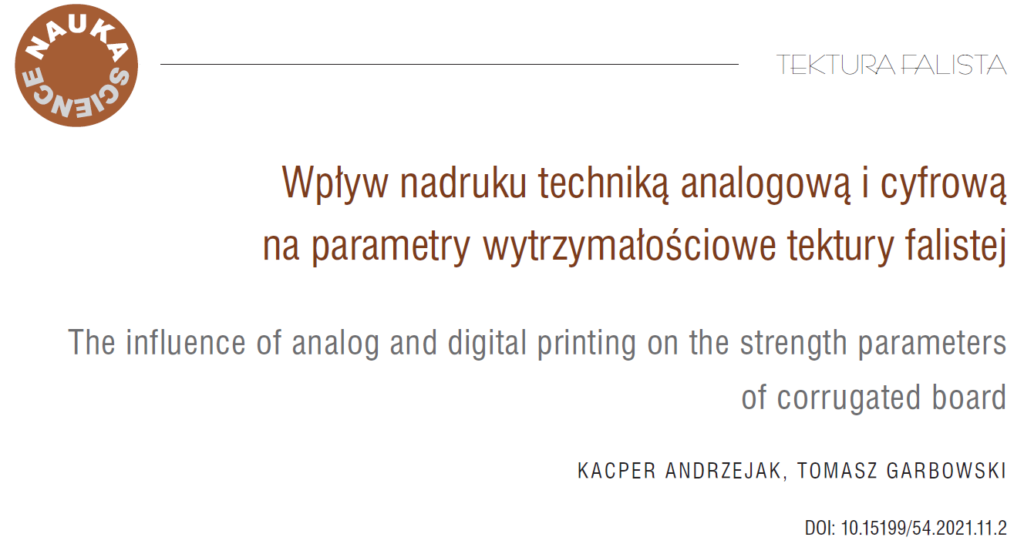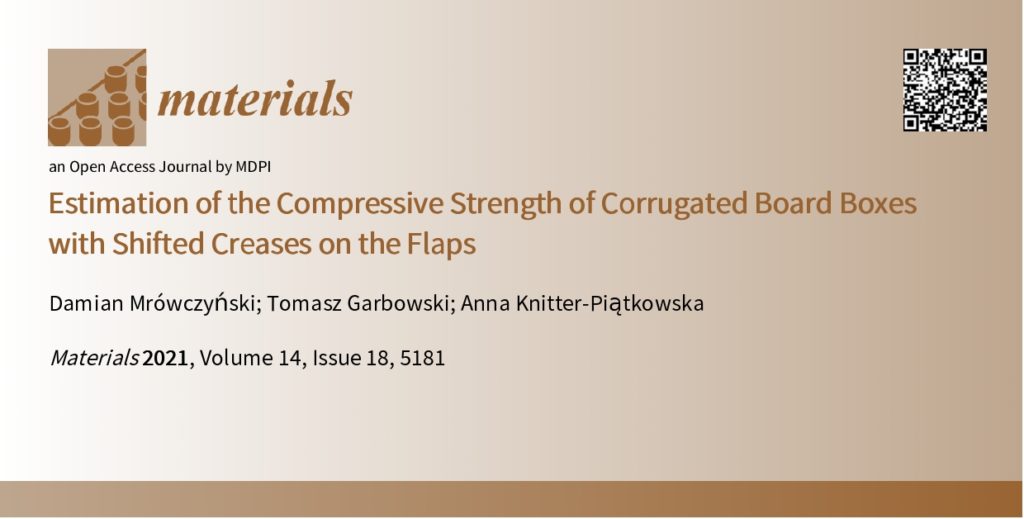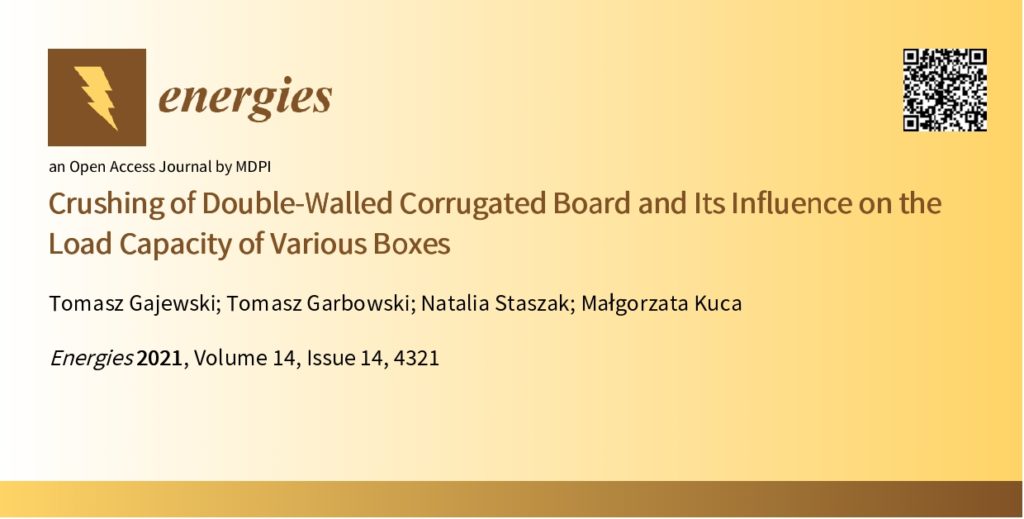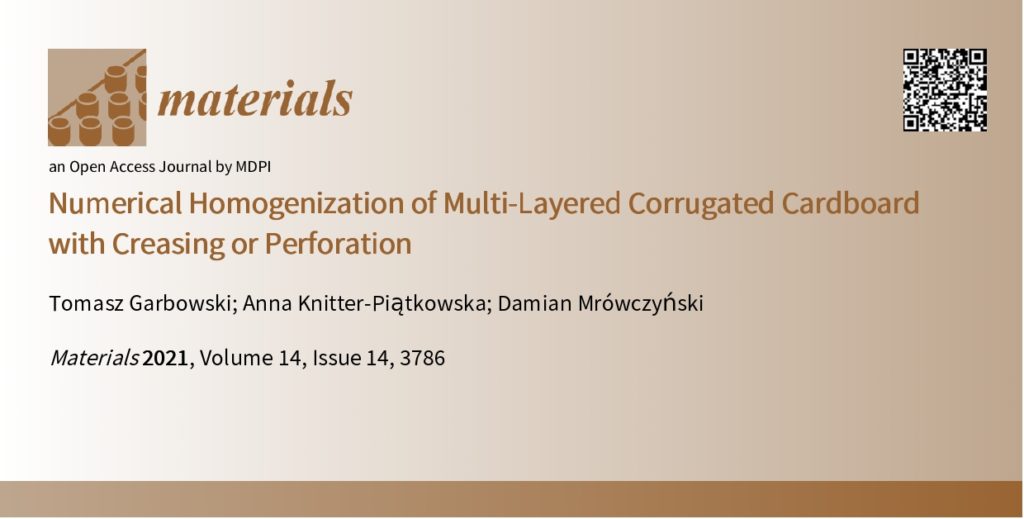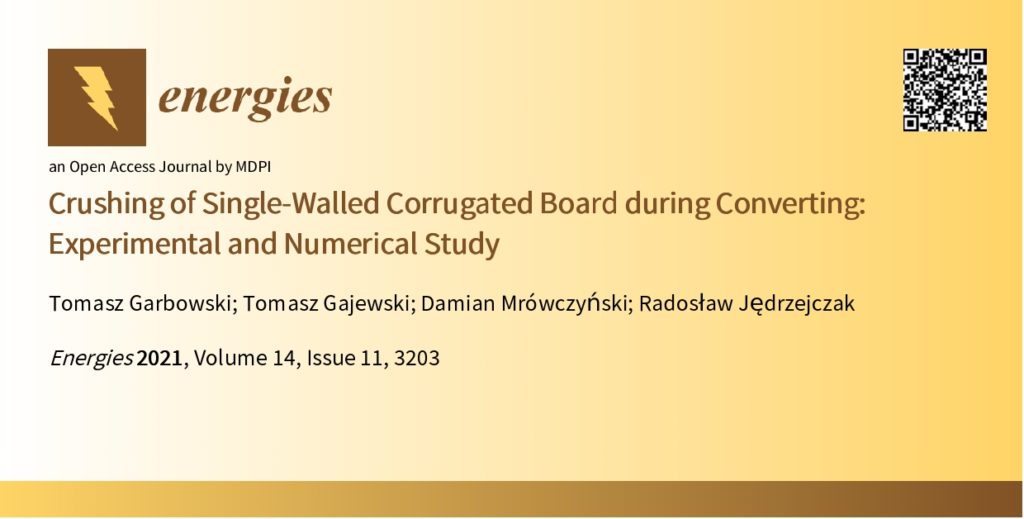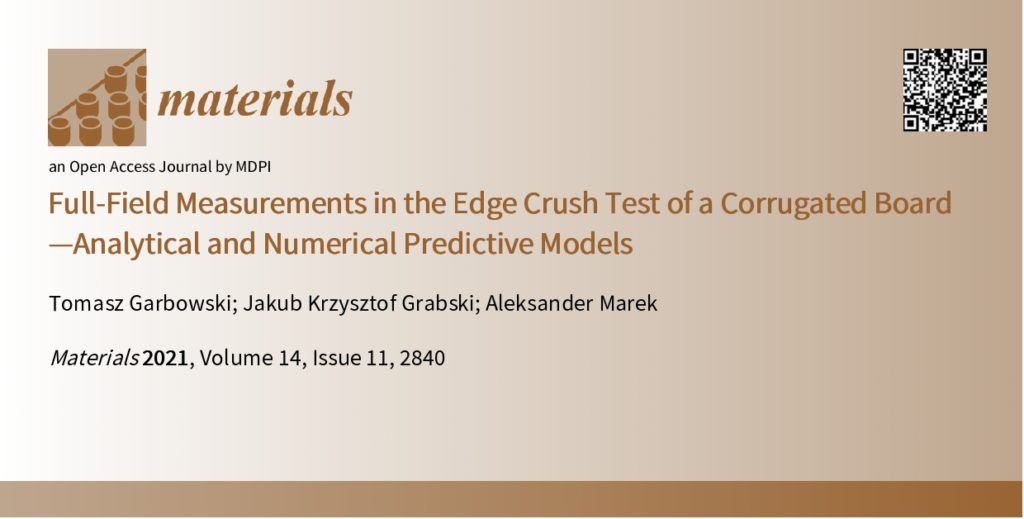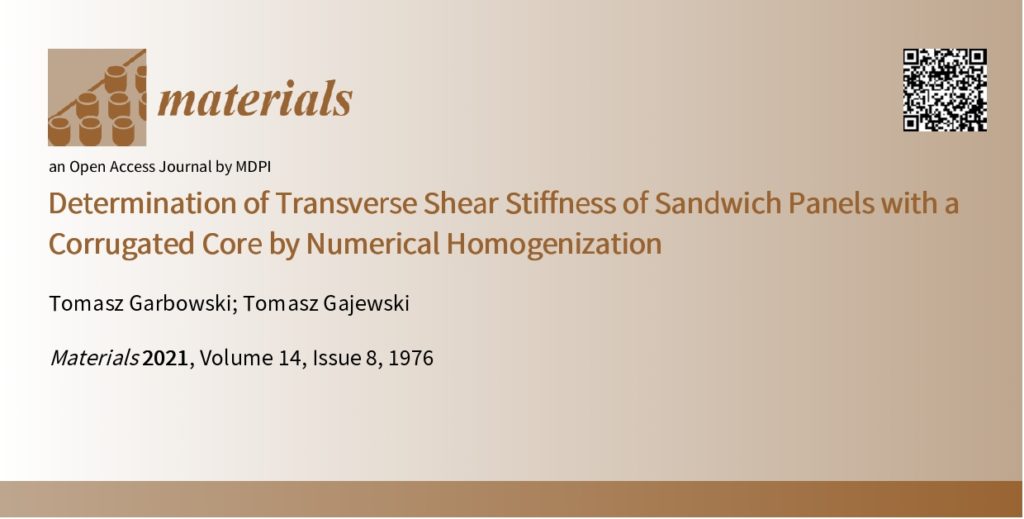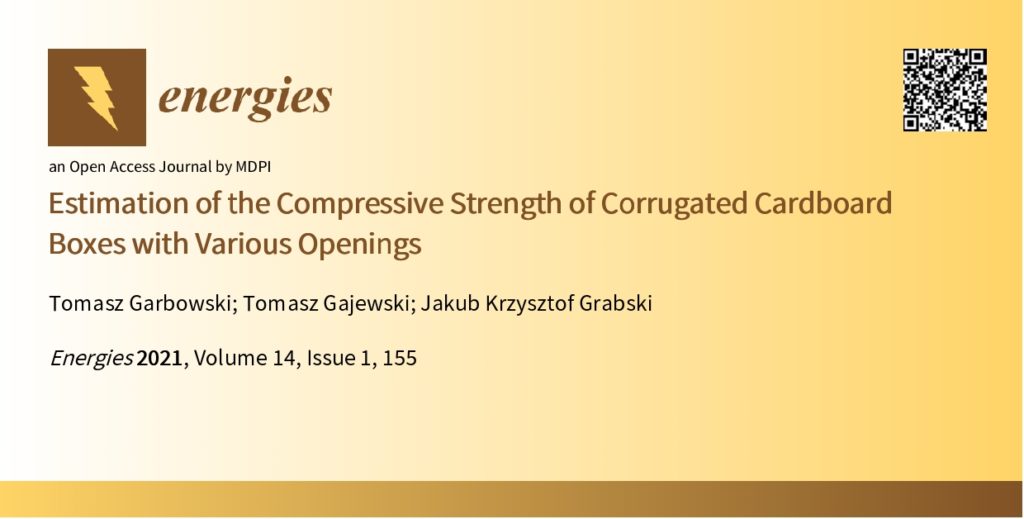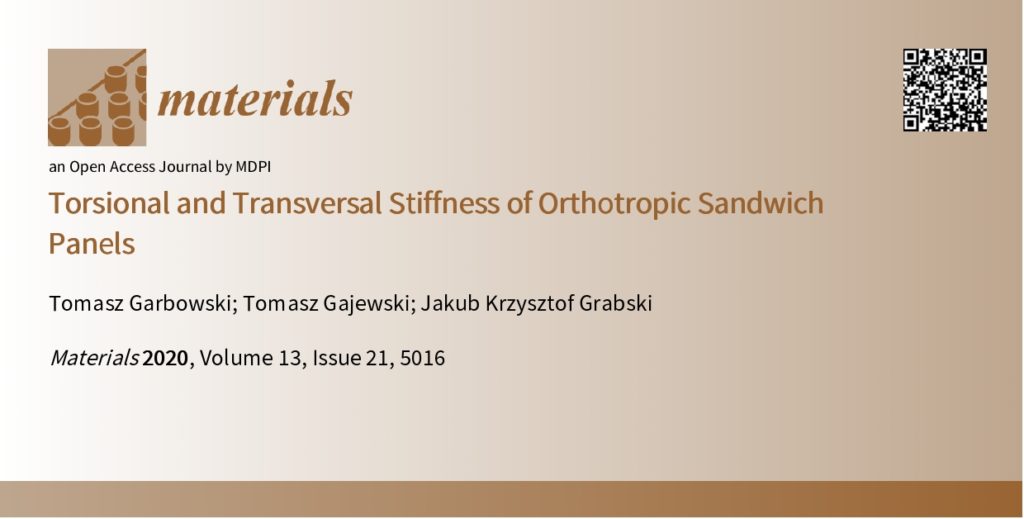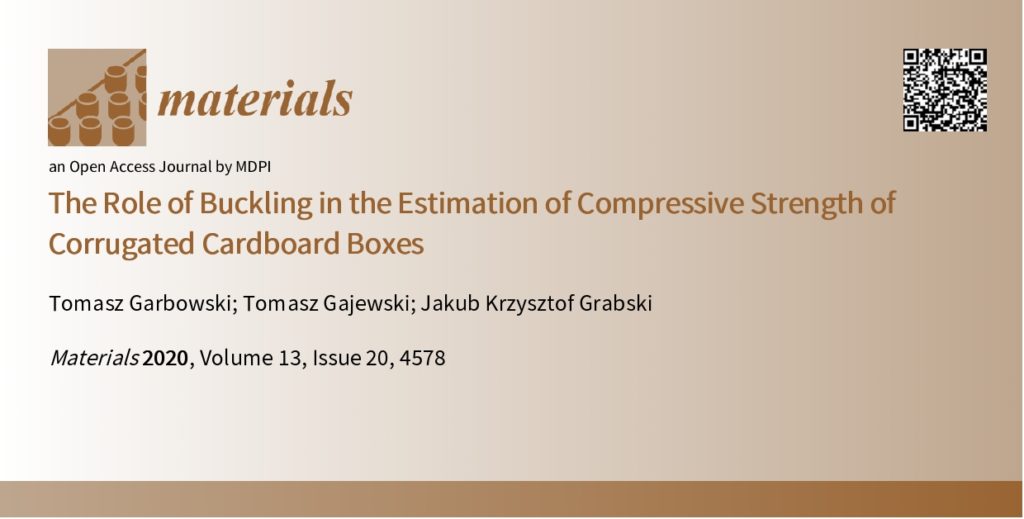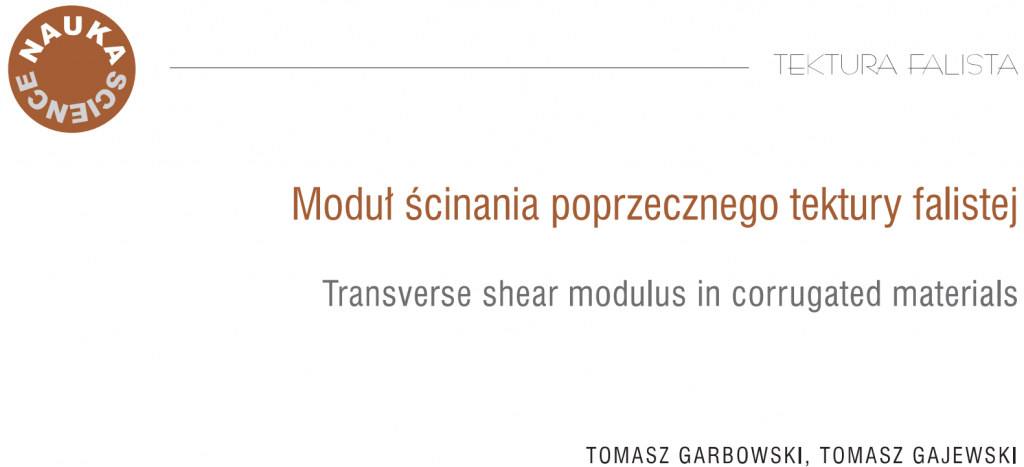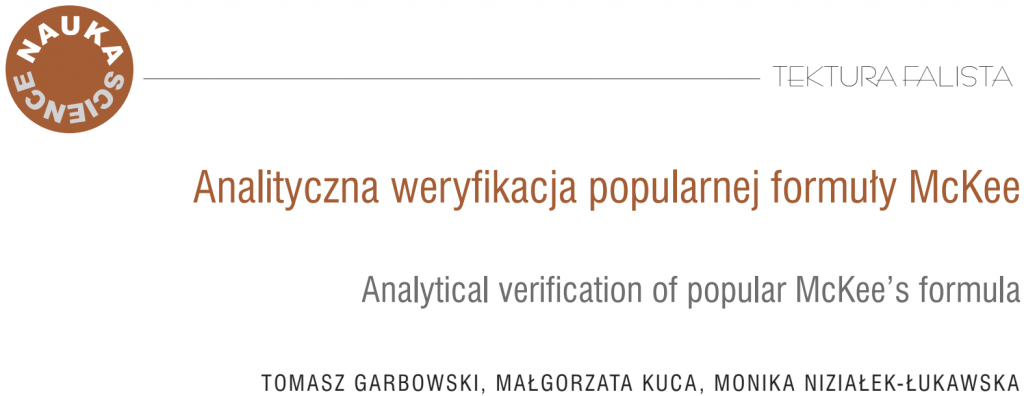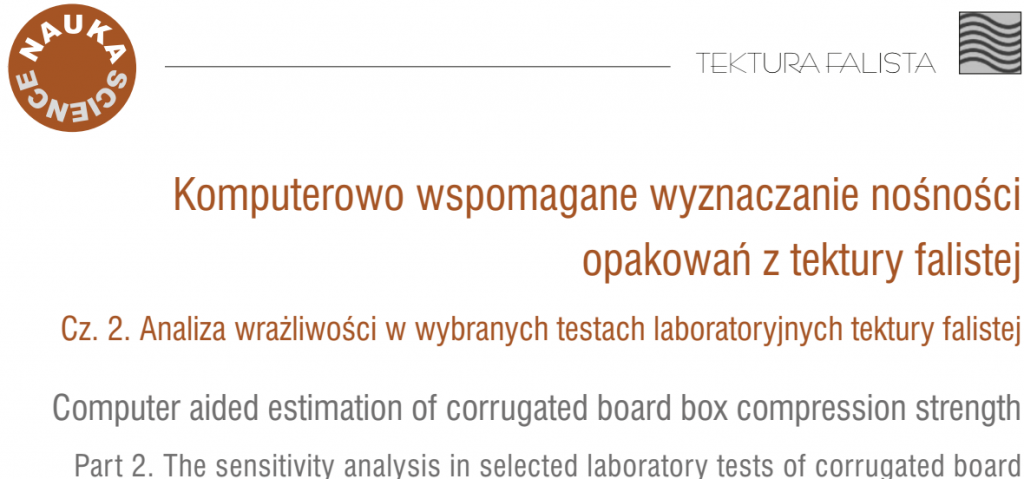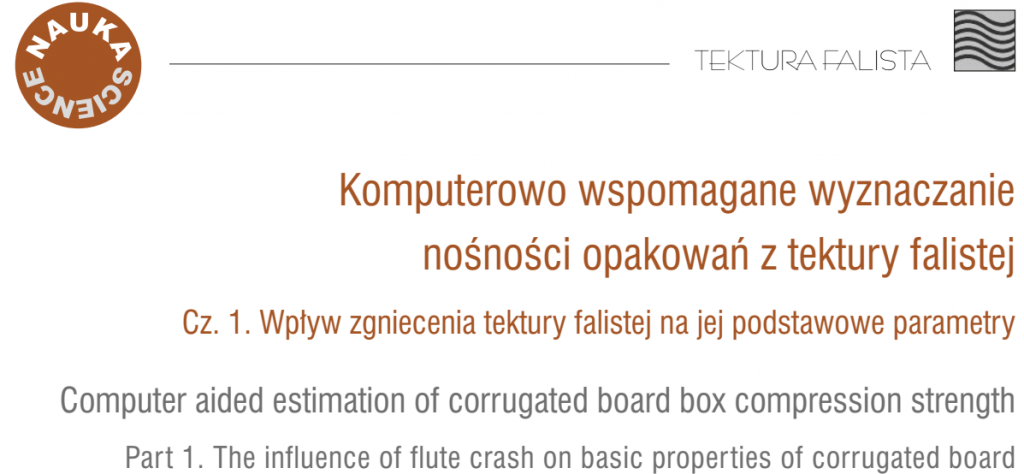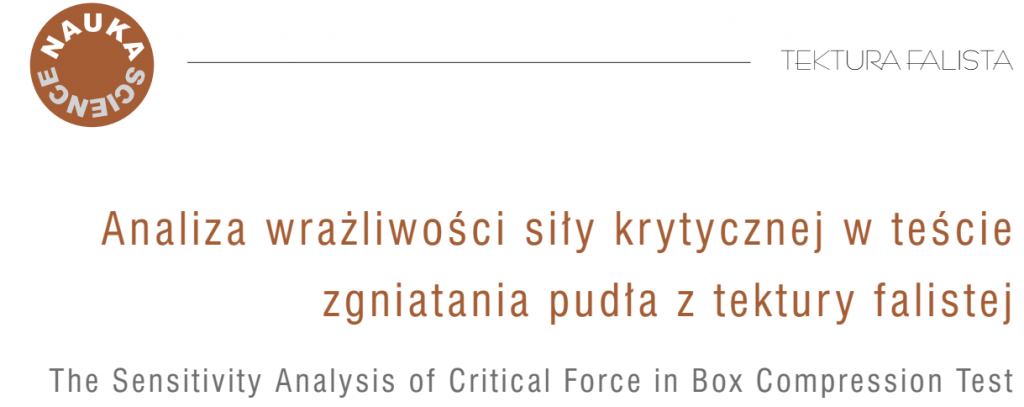Tektura falista jako wszechstronny materiał do opakowań i konstrukcji inżynierskich – przegląd zastosowań
| Polish Paper Review, Vol. 80(12), 678-682, 2024 |
| Corrugated board as a versatile material for packaging and engineering structures – an overview of applications… |
Wpływ badań nad tekturą falistą na cykl życia opakowań
| Packaging Review, Vol. 4, 6-17, 2024 |
| The Impact of Scientific Research on Corrugated Board on the Lifecycle of Packaging… |
Analiza wpływu futurystycznych kształtów warstwy pofalowanej na parametry mechaniczne i koszt trójwarstwowej tektury falistej
| Polish Paper Review, Vol. 80(11), 271-277, 2024 |
| Analysis of the impact of futuristic corrugated layer shape on mechanical properties and cost of single-wall corrugated board… |
Rola homogenizacji w predykcji nośności opakowań z tektury falistej – przegląd metod i zastosowań
| Polish Paper Review, Vol. 80(5), 485-492, 2024 |
| The role of homogenization in predicting the load-bearing capacity of corrugated packaging – a short review of methods and applications… |
Ocena czynników bezpieczeństwa opakowań z tektury falistej w ekstremalnych warunkach środowiskowych
| Packaging Review, Vol. 4, 6-15, 2023 |
| Evaluating safety factors in corrugated packaging for extreme environmental conditions… |
Współczynniki bezpieczeństwa w projektowaniu opakowań z tektury falistej
| Packaging Review, Vol. 3, 16-22, 2023 |
| Safety Factors in the Design of Corrugated Board Packaging… |
Najczęściej popełniane błędy podczas szacowania nośności opakowań z tektury falistej
| Polish Paper Review, Vol. 79(09), 485-488, 2023 |
| The most common mistakes when estimating the load-bearing capacity of corrugated board packaging… |
Zastosowanie sztucznej inteligencji do optymalnej produkcji tektury falistej
| Polish Paper Review, Vol. 79(05), 1-10, 2023 |
| During the production of corrugated board, many dynamic physical and mechanical processes take place, such as the formation of a corrugated layer, gluing of liners with fluting using high temperature and pressure. The dynamic of these processes directly affects the quality of the product, as well as the number and type of possible defects… |
Simplified Modelling of the Edge Crush Resistance of Multi-Layered Corrugated Board: Experimental and Computational Study
| Materials, Vol. 16(01), 458, 2023 |
| The edge crush test is the most popular laboratory test in the corrugated packaging industry. It measures the edge crush resistance of a sample in the cross-fiber direction (CD), also known as the ECT index. This parameter is widely used for the specification of the board by its producers. It is also utilized in most analytical formulas describing the load capacity of the packaging. On the other hand, the ECT value can be estimated from both analytical and numerical models based on the basic parameters of each constituent paper… |
Sensitivity Analysis of Open-Top Cartons in Terms of Compressive Strength Capacity
| Materials, Vol. 16(01), 412, 2023 |
| Trays in which fruit and vegetables are transported over vast distances are not only stored in extreme climatic conditions but are also subjected to long-term loads. Therefore, it is very important to design them correctly and select the optimal raw material for their production. Geometric parameters that define the shape of the packaging may also be optimized in the design process. In this work, in order to select the most important parameters that affect the load capacity of a tray, sensitivity analysis was used… |
Digitization of corrugated board
| Polish Paper Review, Vol. 78(12), 683-686, 2022 |
| Digitization of corrugated board is a very current issue and often taken up by scientists in recent decades. This is undoubtedly related to the global trend for product optimization and thus also to the optimal use of raw materials, and indirectly also to environmental protection. This paper shows two ways of proceeding in the process of digitizing corrugated board… |
Numerical Homogenization of Single-Walled Corrugated Board
with Imperfections
| Applied Sciences, Vol. 12(19), 9692, 2022 |
| Numerical homogenization is an excellent tool for the quick simplification of complex structures with a model that is much simpler and, at the same time, accurately reflects the mechanical behavior of the original model. Corrugated cardboard modeling, with all geometrical nuances preserved, is a complicated and time-consuming process… |
Optimal corrugated board – what does it mean?
| Polish Paper Review, Vol. 78(06), 337-341, 2022 |
| Corrugated board is characterized by an excellent ratio of load capacity to its volume. This means that with a relatively low weight, this material has surprisingly high strength, which is most influenced by its multi-layer structure, in particular the use of alternating flat and corrugated layers. The geometry and structure of the corrugated board resembles an orthotropic sandwich panels, which are characterized by very high compressive strength and bending stiffness in both directions….. |
Influence of Analog and Digital Crease Lines on Mechanical Parameters of Corrugated Board and Packaging
| Sensors, Vol. 22(13), 4800, 2022 |
| When producing packaging from corrugated board, material weakening often occurs both during the die-cutting process and during printing. While the analog lamination and/or printing processes that degrade material can be easily replaced with a digital approach, the die-cutting process remains overwhelmingly analog. Recently, new innovative technologies have emerged that have begun to replace or at least supplement old techniques…. |
Influence of initial imperfections on edge crush resistance of corrugated board
| Polish Paper Review, Vol. 78(06), 337-341, 2022 |
| Recycled, lightweight papers that are increasingly used in the production of corrugated board are very prone to buckling. Even without preload or production stresses, both the flat layers (liners) and the fluting layers are slightly curved. Additionally, each, even a small, crush of the corrugated board slightly changes the shape of the corrugated layers and often leads to micro-damage and delamination, i.e. breaking the connections between cellulose fibers… |
From paper to corrugated board – modeling the edge crush test
| Polish Paper Review, Vol. 78(05), 271-277, 2022 |
| Designing corrugated board packaging is a real challenge, especially when the packaging material comes from multiple recycling. Recycling itself is a pro-ecological and absolutely necessary process, but the mechanical properties of materials that are processed many times deteriorate with the number of cycles. Manufacturers are trying to use unprecedented design methods to preserve the load bearing capacity of packaging, even when the material itself is of deteriorating quality… |
Relationship between SCT of paper and ECT of single-wall corrugated board
| Polish Paper Review, Vol. 78(04), 210-216, 2022 |
| Corrugated board is a material composed of several alternating flat and corrugated layers of paper. The basis weight of the individual layers is usually selected in the range of 80-180 g/m2. Both the basis weight and the ratio of virgin to recycle fibers of the selected paper depend on its intended use in the production of corrugated board. For flat layers, papers containing some virgin fibers are most often used, while for corrugated layers, mainly lighter recycled papers are used… |
Optimal Design of Double-Walled Corrugated Board Packaging
| Materials, Vol. 15(06), 2149, 2022 |
| Designing corrugated board packaging is a real challenge, especially when the packaging material comes from multiple recycling. Recycling itself is a pro-ecological and absolutely necessary process, but the mechanical properties of materials that are processed many times deteriorate with the number of cycles. Manufacturers are trying to use unprecedented design methods to preserve the load bearing capacity of packaging, even when the material itself is of deteriorating quality… |
Non‐Local Sensitivity Analysis and Numerical Homogenization in Optimal Design of Single‐Wall Corrugated Board Packaging
| Materials, Vol. 15(03), 0720, 2022 |
| The optimal selection of the composition of corrugated cardboard dedicated to specific packaging structures is not an easy task. The use of lighter boards saves material, but at the same time increases the risk of not meeting the guaranteed load capacity. Therefore, the answer to the question “in which layer the basis weight of the paper should be increased?” is not simple or obvious. The method proposed here makes it easy to understand which components and to what extent they affect the load‐bearing capacity of packages of various dimensions… |
Analytical Determination of the Bending Stiffness of a Five-Layer Corrugated Cardboard with Imperfections
| Materials, Vol. 15(02), 0663, 2022 |
| The standard edge crush test (ECT) allows the determination of the crushing strength of the corrugated cardboard. Unfortunately, this test cannot be used to estimate the compressive stiffness, which is an equally important parameter. This is because any attempt to determine this parameter using current lab equipment quickly ends in a fiasco. The biggest obstacle is obtaining a reliable measurement of displacements and strains in the corrugated cardboard sample… |
The influence of analog and digital printing on the strength parameters of corrugated board
| Polish Paper Review, Vol. 77(11),593-599, 2021 |
| After production, the corrugated board undergoes further processing before it is finally formed into a specific shape, e.g. a package or a stand. Converting processes include, but are not limited to, printing, laminating, cutting, gluing and folding. All of them affect, to a greater or lesser extent, the strength parameters of the corrugated board… |
New Edge Crush Test Configuration Enhanced with Full-Field Strain Measurements
| Materials, Vol. 14(19), 5768, 2021 |
| Bending stiffness (BS) is one of the two most important mechanical parameters of corrugated board. The second is edge crush resistance (ECT). Both are used in many analytical formulas to assess the load capacity of corrugated cardboard packaging. Therefore, the correct determination of bending stiffness is crucial in the design of corrugated board structures. This paper focuses on the analytical determination of BS based on the known parameters of the constituent papers and the geometry of the corrugated layers… |
Estimation of the Compressive Strength of Corrugated Board Boxes with Shifted Creases on the Flaps
| Materials, Vol. 14(18), 5181, 2021 |
| In the modern world, all manufacturers strive for the optimal design of their products. This general trend is recently also observed in the corrugated board packaging industry. Colorful prints on displays, perforations in shelf-ready-packaging and various types of ventilation holes in trays, although extremely important for ergonomic or functional reasons, weaken the strength of the box… |
Crushing of Double-Walled Corrugated Board and Its Influence on the Load Capacity of Various Boxes |
| Energies, Vol. 14(14), 4321, 2021 |
| As long as non-contact digital printing remains an uncommon standard in the corrugated packaging industry, corrugated board crushing remains a real issue that affects the load capacity of boxes. Crushing mainly occurs during the converting of corrugated board (e.g., analog flexographic printing or laminating) and is a process that cannot be avoided… |
Numerical Homogenization of Multi-Layered Corrugated Cardboard with Creasing or Perforation |
| Materials, Vol. 14(14), 3786, 2021 |
| Corrugated cardboard is an ecological material, mainly because, in addition to virgin cellulose fibers also the fibers recovered during recycling process are used in its production. However, the use of recycled fibers causes slight deterioration of the mechanical properties of the corrugated board… |
Crushing of single-walled corrugated board during converting: experimental and numerical study |
| Energies, Vol. 14(11), 3203, 2021 |
| Corrugated cardboard is an ecological material, mainly because, in addition to virgin cellulose fibers also the fibers recovered during recycling process are used in its production. However, the use of recycled fibers causes slight deterioration of the mechanical properties of the corrugated board… |
Full-Field Measurements in the Edge Crush Test of a Corrugated Board |
| Materials, Vol. 14(11), 2840, 2021 |
| This article focuses on the derivation of simplified predictive models for the identification of the overall compressive stiffness and strength of corrugated cardboards. As a representative example an unsymmetrical 5-ply sample (with E and B flute) was used in this study… |
Determination of transverse shear stiffness of sandwich panels with a corrugated core by numerical homogenization |
| Materials, Vol. 14(8), 1976, 2021 |
| In this work, the method proposed by Biancolini is extended to include the possibility of determining, apart from the tensile and flexural stiffnesses, also the transverse shear stiffness of the homogenized corrugated board… |
Estimation of the compressive strength of corrugated cardboard boxes with various perforations |
| Energies, Vol. 14(4), 1095, 2021 |
| This paper presents a modified analytical formula for estimating the static top-to-bottom compressive strength of corrugated board packaging with different perforations. The analytical framework is based here on Heimerl’s assumption… |
Estimation of the compressive strength of corrugated cardboard boxes with various openings |
| T.Garbowski, T.Gajewski, J.K.Grabski |
| Energies, Vol. 14(1), 155, 2021 |
| This paper presents mixed analytical/numerical method for estimating the static top-tobottom compressive strength of corrugated packaging with different ventilation openings and holes, in which the torsional and shear stiffness of corrugated cardboard as well as the panel depth-to-width ratio are included… |
Torsional and Transversal Stiffness of Orthotropic Sandwich Panels |
| T.Garbowski, T.Gajewski, J.K.Grabski |
| Materials 2020, Vol. 13(21), 5016, 2020 |
| In the present work, an analytical equation describing the plate torsion test taking into account the transverse shear stiffness in sandwich plates is derived and numerically validated. Transverse shear becomes an important component if the analyzed plate or shell is th… |
The Role of Buckling in the Estimation of Compressive Strength of Corrugated Cardboard Boxes |
| T.Garbowski, T.Gajewski, J.K.Grabski |
| Materials 2020, Vol. 13(20), 4578, 2020 |
| This paper presents analytical methods for estimating the static top-to-bottom compressive strength of simple corrugated packaging, in which the torsional and shear stiffness of corrugated cardboard as well as the panel depth-to-width ratio are included. The methods are… |
Role of Transverse Shear Modulus in the Performance of Corrugated Materials |
| T.Garbowski, T.Gajewski, J.K.Grabski |
| Materials 2020, Vol. 13(17), 3791, 2020 |
| In a description of materials for orthotropic panels with a soft and/or corrugated core, it is important to correctly determine all constitutive parameters. In laboratory practice, the determination of transverse shear modulus is often overlooked. This paper presents a … |
Moduł ścinania poprzecznego tektury falistej |
| T.Garbowski, T.Gajewski |
| Przegląd papierniczy, Vol. 76(2), pp.103-108, 2020 |
| W opisie materiałowym ortotropowych płyt z miękkim i/lub pofalowanym rdzeniem ważne jest poprawne wyznaczenie wszystkich parametrów konstytutywnych. Niestety, w praktyce laboratoryjnej często pomija się wyznaczenie modułu ścinania poprzecznego. W niniejszej pracy przeds… |
Analityczna weryfikacja popularnej formuły McKee |
| T.Garbowski, M.Kuca , M.Niziałek-Łukawska |
| Przegląd papierniczy, Vol. 75(12), pp.767-773, 2019 |
| W pracy przedstawiono krytyczne spojrzenie na popularną metodę estymacji wytrzymałości statycznej prostych opakowań z tektury falistej. Metoda, choć ma już ponad pięćdziesiąt lat, przetrwała próbę czasu i wciąż cieszy się ogromną popularnością wśród konstruktorów opakow… |
Komputerowo wspomagane wyznaczanie nośności opakowań z tektury falistej. Cz.3. Laboratoryjno-numeryczna procedura identyfikacji sprężystych parametrów materiałowych tektury falistej |
| T.Garbowski, L.Garbowska |
| Przegląd papierniczy, Vol. 74(9), pp. 577-585, 2018 |
| Wiarygodne szacowanie nośności konstrukcji z papieru oraz tektury (np. pudła klapowe, SRP/RRP itp.) oparte jest przede wszystkim na precyzyjnie zidentyfikowanym zestawie parametrów wytrzymałościowych oraz odpowiednim modelu matematycznym z poprawnie sformułowanymi równa… |
Komputerowo wspomagane wyznaczanie nośności opakowań z tektury falistej. Cz.2. Analiza wrażliwości w wybranych testach laboratoryjnych tektury falistej |
| T.Garbowski, L.Garbowska |
| Przegląd papierniczy, Vol. 74(8), pp. 435-440, 2018 |
| W procesie numerycznego (komputerowego) wyznaczania nośności opakowań z tektury falistej bardzo ważnym krokiem jest precyzyjne wyznaczenie parametrów materiałowych tektury. Ponieważ tektura falista jest materiałem charakteryzującym się dużą heterogenicznością, ortotropi… |
Komputerowo wspomagane wyznaczanie nośności opakowań z tektury falistej. Cz.1. Wpływ zgniecenia tektury falistej na jej podstawowe parametry |
| T.Garbowski, I.Czelusta, Ł.Graczyk |
| Przegląd papierniczy, Vol. 74(6), pp. 381-388, 2018 |
| Niniejsza praca rozpoczyna cykl publikacji dotyczących numerycznego (komputerowego) wyznaczania nośności opakowań z tektury falistej. Zagadnienia przedstawione w tym i kolejnych artykułach związane są bezpośrednio lub pośrednio z procesem określania maksymalnej siły, ja… |
Analiza wrażliwości siły krytycznej w teście zgniatania pudła z tektury falistej |
| T.Garbowski, G.Przybyszewski |
| Przegląd papierniczy, Vol. 71(5), pp. 275-280, 2015 |
| W pracy przedstawiono szczegółową analizę stateczności globalnej pudeł klapowych typu FEFCO. Do analizy przyjęto, że pudła wykonane są z tektury falistej 3- lub 5-warstwowej. Warstwy pofalowane przekroju (fluting), z uwagi na ich periodyczność, są homogenizowane (tj. wy… |





